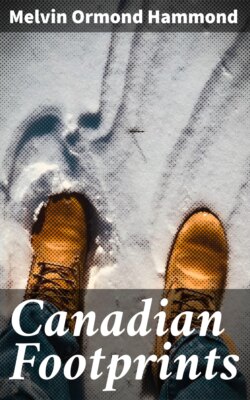Читать книгу Canadian Footprints - Melvin Ormond Hammond - Страница 18
Jacques Cartier at Quebec
ОглавлениеAFTER its tumultuous course down the Laurentians, the St. Charles River flows placidly through the City of Quebec and in its level reaches is at the mercy of the deep tides which sweep in from the St. Lawrence. Beside an industrial suburb bearing the musical name of Limoilou there is a little park facing the St. Charles, and within it are a tall wooden cross and a modest shaft of classical lines. They mark the wintering place of Jacques Cartier in 1535-6, during the momentous voyage in which he discovered Canada.
In the great movement for colonial expansion which was gripping Western Europe, Cartier, loyal and enterprising, had served King Francis I by seeking new lands in the west. Francis, the benevolent autocrat, desired his share in the spoils, and with an army and navy was able to implement the genial command with which he concluded all his laws:
“For such is our good pleasure.”
Cartier’s faithful company came in three small ships, the largest, the Grand Hermine, being of 120 tons burden. The largest ship entering Quebec today (1926), the “Empress of Scotland,” is 37,700 tons. As Cartier ascended the St. Lawrence he scattered place-names with prodigality and good taste, and declared it a “goodly land.” The valley of the St. Lawrence inspired him as being “as fine a land and as level as ever one beheld.” Grapes on the Island of Orleans led him to call it the Isle of Bacchus, while forest and fruit trees on the mainland reminded him of the fair France itself.
At Quebec the wily Indians, while giving Cartier a welcome, sought to dissuade him from going up the river to Hochelaga (Montreal). For that purpose they dressed three redskins as devils, with long horns and black faces, but Cartier was not so easily scared by theatricals. On the site of the future metropolis he was met by one thousand Indians and conducted to their village near Mount Royal.
A fort was now built by Cartier’s men, and the ships wintered in the St. Charles three miles from the St. Lawrence, near the Charlesbourg Road, which two centuries later led to the Chateau Bigot, made famous by Kirby’s novel, “The Golden Dog.” Frenchmen and Indians mingled, and Cartier learned of the rich products of the soil and the many animals and birds of the valley, and tested the tobacco of the red men, which when smoked burned his mouth like pepper.
Midwinter brought not only distressing weather but an outbreak of malignant scurvy among the uncomfortable Frenchmen. Twenty-five had died and over fifty were seriously ill, when an Indian told Cartier of a drink from a tree bark, and soon all patients were cured.
On May 3, 1536, Cartier raised a cross on the site of the cross of today, bearing the legend:
Francis I, by the Grace of God King of the French, is Sovereign.
Cartier had set up his claim to Canada. He returned to France but left no settlement. It remained for Champlain, nearly seventy-five years later, to found Quebec and give permanency to New France.
On a September morning in 1759 the banks of the St. Charles witnessed the fleeing army of Montcalm pursued down the slopes of Cape Diamond by the Fraser Highlanders after the victory of Wolfe. Today the slopes are terraced by streets of homes of happy citizens of both French and English races.
Jacques Cartier’s Wintering Place, Quebec
